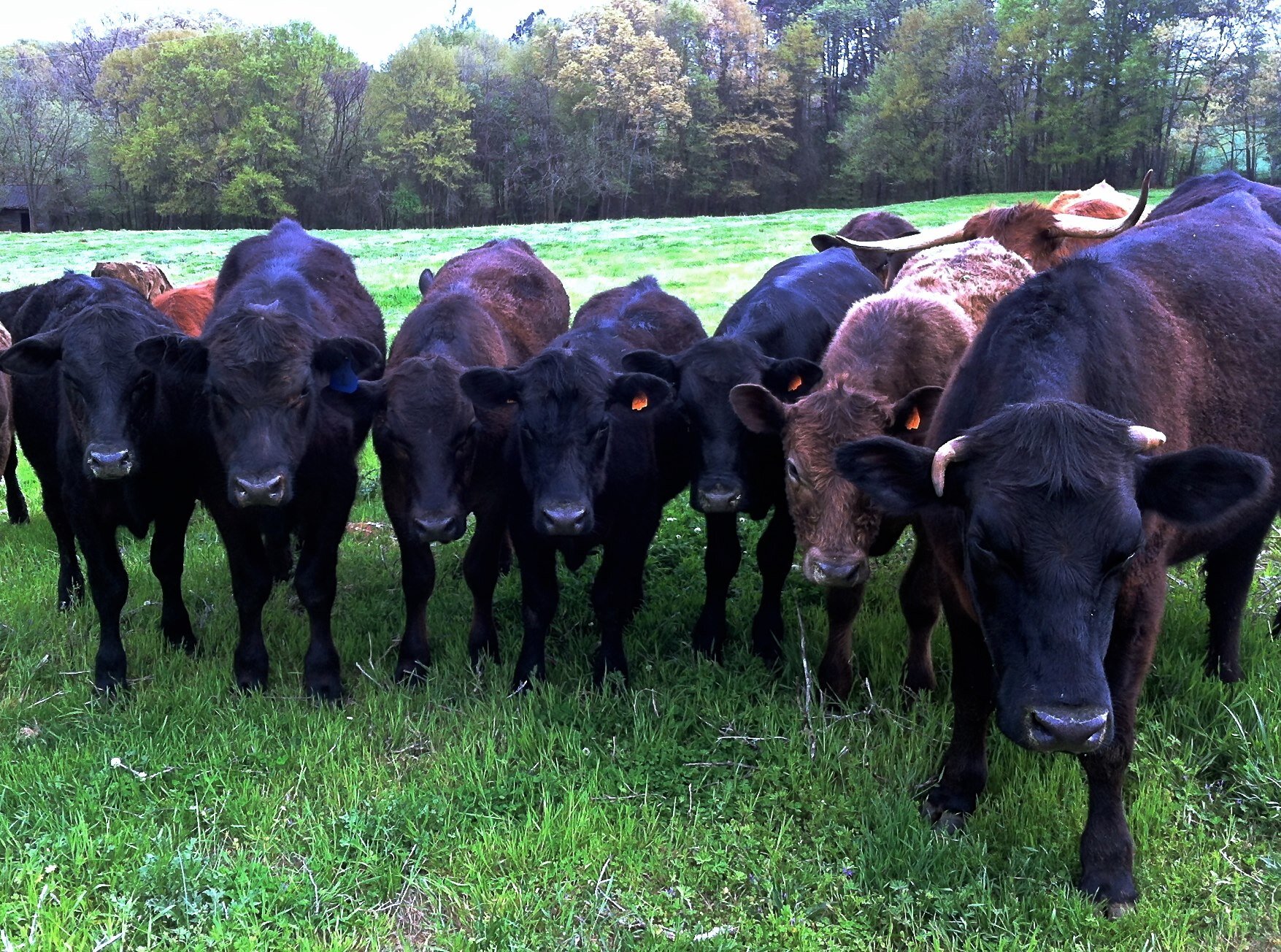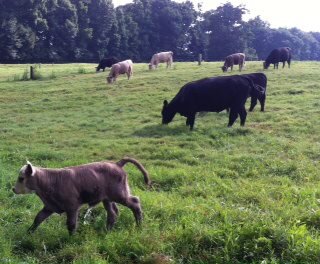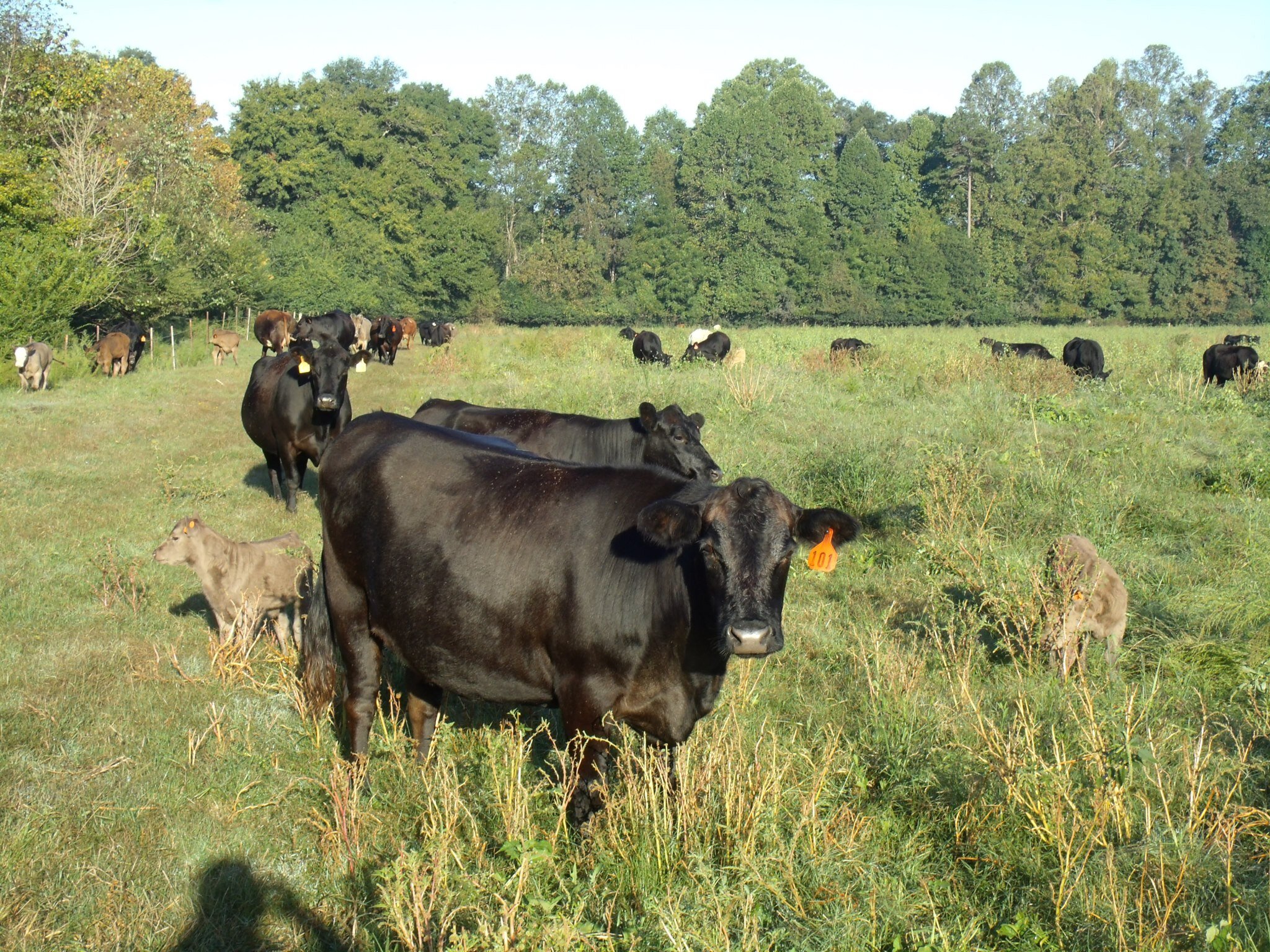Benefits of 100% Grass-Fed Beef
What does “100% Grass-Fed” mean? For Indian Creek, “100% Grass-Fed” means that our cattle are not fed with grain, growth hormones, or antibiotics. They graze on chemical-free grass in their entire lives—no pesticides, no synthetic fertilizers, just natural organic grass and other greens like clover and chicory all year, supplemented with pesticide-free hay in the winter. Meanwhile, most beef is grain-finished, which means the cattle eat lots of corn, soy, and other grains during the months before they are slaughtered.
Environmental Benefits of 100% Grass-Fed Beef
Feedlot cattle stand in manure lagoons with nitrogen and phosphorus levels that contain heavy metals and hormone residues that create toxic waste.
Certified Naturally Grown, 100% Grass-Fed cattle are raised on pastures that are naturally fertilized (no chemicals) and fed all natural hay as supplements in the winter.
By not shipping cattle to feed lots, we lower transportation costs and fossil fuel use.
Grass in pastures absorbs more methane in a day than a cow can produce in a year.
Health Benefits of 100% Grass-Fed Beef
Eating 100% Grass-Fed beef helps lower the risk of heart disease, and it has the following advantages over grain-finished beef:
10 times higher in beta carotene
5 times higher in CLA (conjugated linoleic acid), which has antioxidant properties
Half the saturated fat content
4-6 times lower in overall fat
2-4 times higher in Omega-3 fatty acids and a healthier ratio of Omega-3s to Omega-6s
4 times higher Vitamin E
Higher in Vitamin C
Higher in Vitamin B: thiamin and riboflavin
Higher in Calcium, Magnesium and Potassium
Virtually no risk of E coli
No antibiotics, hormones or steroids used
No by-product feed-stuffs used
How is 100% Grass-Fed Different than Grain-Finished Beef?
100% Grass-Fed beef looks different than grain-finished beef. The yellow in the fat is the natural beta-carotene that pastured cattle gain from eating grass. The meat is darker because it is leaner.
100% Grass-Fed beef will taste a little different than grain-finished beef. It is aged longer (usually 21 days, instead of 10 or fewer days), has less fat, and is more flavorful. Eating 100% Grass-Fed beef is like drinking fine, aged wine—a cultivated taste.
100% Grass-Fed beef should be cooked differently in order to retain the juices that tenderize the beef. View our tips for cooking 100% Grass-Fed beef.
100% Grass-Fed beef costs more, because feedlot beef prices are artificially low due to farm subsidies. They also do not take into account the costs to taxpayers for repair of environmental damage.
“Researchers have also compared key antioxidants in meat from Grass-Fed and grain-fed cattle. The Grass-Fed meat was higher in Vitamin C, Vitamin E, and folic acid. It was also 10 times higher in beta-carotene.”
— Nicholas Perricone, 7 Secrets to Beauty, Health, and Longevity
Moral Reasons to Buy 100% Grass-Fed Beef
Cows are by nature designed to eat grass, but industrial feedlots, which supply most supermarket meat, force them to eat grain to fatten and “marble” the meat.
Corn-fed beef is part of the industrial food chain powered by fossil fuels (petroleum) and defended by the U.S. military.
Factory farms may use (non-ruminant) animal protein for feed.
Because feedlot cattle are fed an unnatural diet of grain, they are sick to one degree or another and require antibiotics just to stay alive.
Our 100% Grass-Fed cattle are treated humanely their entire lives, even in the slaughterhouse.
Why Buy Local Grass-Fed Beef
Purchasing local, 100% Grass-Fed beef supports your Georgia farmers.
Purchasing local food lays the groundwork for new social, economic, and ecological relationships.
Purchasing local, 100% Grass-Fed beef supports an agricultural landscape that protects grasslands and watersheds.
Locally-raised 100% Grass-Fed beef is based on free solar energy and no chemical use.
Buying local allows you to understand your connection to the food chain and see exactly where your food comes from.
Buying local reduces reliance on foreign oil.
What is Local?
For many environmentally-sensitive eaters, purchasing local produce and meat means purchasing within a 100-mile radius of home. Indian Creek is within 100 miles of Atlanta, Gainesville, Augusta, and Athens, Georgia. Buying a side or a quarter of beef means fewer shopping trips and lower fuel consumption.
Health Advocates that Recommend Grass-Fed Meats:
Why is Grass-Fed Beef Considered Gourmet Beef:
Producing gourmet, artisanal beef requires hands-on care, quality breeds, and craftsman processing. Indian Creek 100% Grass-Fed beef combines all these factors to produce high-quality, organically-raised, nutritious beef.
Our Northeast Georgia soil is excellent for raising healthy cattle. Without pesticides or synthetic fertilizers, our soils are naturally fertilized by cattle that are rotated daily, leaving behind the best fertilizer a pasture can receive.
Our grasses include tall fescue, Bermuda, annual rye, and rye grass. In addition, our cattle eat clover, chicory, winter annual forbs, and various “weeds” that enrich their diets. They have a virtual salad bar to choose from. Greater variety produces more nutritional beef. And our cattle do not consume any grains, such as soy or corn, antibiotics, hormones, or other chemicals. They are 100% Grass-Fed.
Pasture management requires continual observation and care to ensure the cattle have all the grass, minerals, water, and shade they need. Daily rotation allows us to check every animal at least once a day.
We operate transparently. That means that you are welcome to come and inspect our farm, walk the pastures, see the cattle, smell the grass, call our processor and ask any questions you would like to. We believe that information about what you eat should be completely open and accessible to you.
Our cattle breeds originate from black and red Angus and other breeds that include Murray Grey, a genetic cross between Angus and Shorthorn that came from Australia before feedlots were in place. They are excellent beef breeds, but we continually improve our herds by keeping only the best mothers with the finest traits for beef. These traits include plenty of milk, solid muscle mass, short legs, good protective mothering skills, and docility. (Docility as well as low stress handling reduces cortisol in their systems. Cortisol toughens meat.)
We handle our cattle in a low-stress way. We never run them or whoop and shout. We never use cattle prods or other painful techniques. The cattle are trained to move to another pasture daily and they come when we call. When you visit the farm you can see how peaceful their lives are.
When we transport our cattle to the processor, we take them at least two at a time to reduce their stress. They spend the night at the processor and are calm in the morning when they are killed. Both our processor and our farm are Animal Welfare Approved, which means an independent agent inspected both facilities and determined that we treat our animals in the most humane way possible.
Our beef is dry-aged for 21 days. Dry-aging makes the meat much more flavorful and tender, but the beef also loses weight during the aging process. For that reason dry-aging is not generally used in commercial beef production. Only top-tier steak houses age their beef. Dry-aging also requires more work on the part of the processor. Because some weight is lost during the aging process, the cost per pound is higher than grocery store beef. The processor is the best judge of how long the beef can age for optimum flavor and tenderness, and every beef will be different because of size, age, and climactic factors.
We trust our processor completely. He and his staff are balancing two goals: they attempt to get as much meat as possible for our customers while also cutting the best steaks and roasts they can. How our processor handles your beef is what completes the profile for artisanal beef. Contact us if you’d like us to explain how you would like the beef processed. Special requests are welcomed.
Finally, the way your Grass-Fed beef is cooked will influence your dining experience. Because 100% Grass-Fed beef is relatively lean, it must be cooked a little differently than grocery store beef in order to keep it as moist and tender as possible. For advice, see our Cooking Tips. Once you’ve tried our artisanal Grass-Fed beef, you won’t go back to the beef that over 90% of Americans are eating.
Other Health, Environmental and Nutrition Resources
“The FDA’s Willful Evasion of Science” by Robert S. Lawrence, The Atlantic
EatWild, an excellent resource about the benefits of eating outside the industrial food system
Robyn O’Brien talks about the effects of chemicals on our health
“A Farm for the Future“ a BBC documentary about the energy crisis and the future of farming
“Voting with your Fork“ by Michael Pollan, The NY Times
“Healthy Soils, Healthy People: The Legacy of William Albrecht“ by John Ikerd
“Nourishing Traditions: The Cookbook that Challenges Politically Correct Nutrition and the Diet Dictocrats” by Fallon, Sally, (with Mary G. Enig), Washington, D.C.: New Trends, 1999 and 2001. (Note: Fallon believes grain-finishing pastured cattle is in keeping with natural eating patterns, but recent studies have shown that beef is more nutritious if the cattle receive no grain at all. Look for 100% Grass-Fed beef.)
“Report links antibiotics at farms to human deaths” by Carolyn Lochhead








